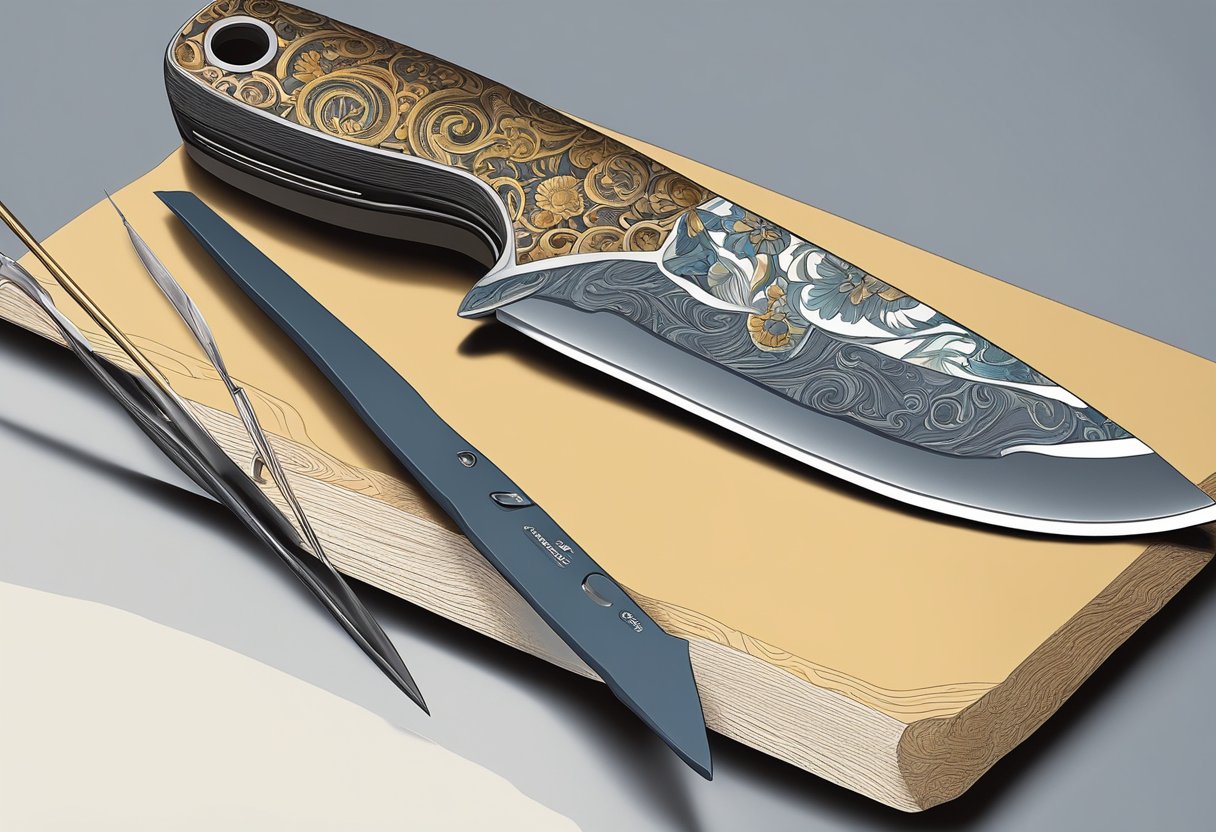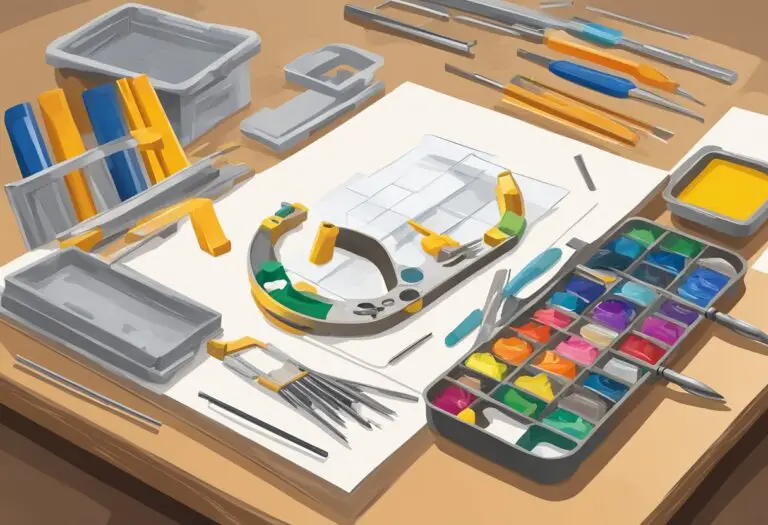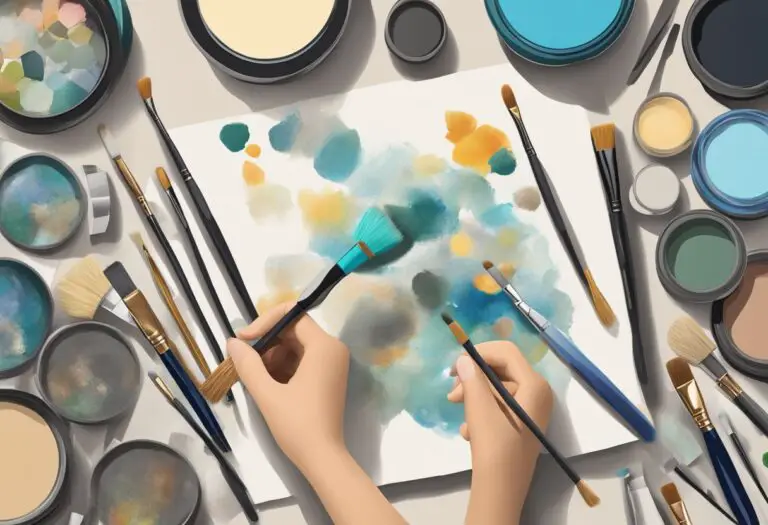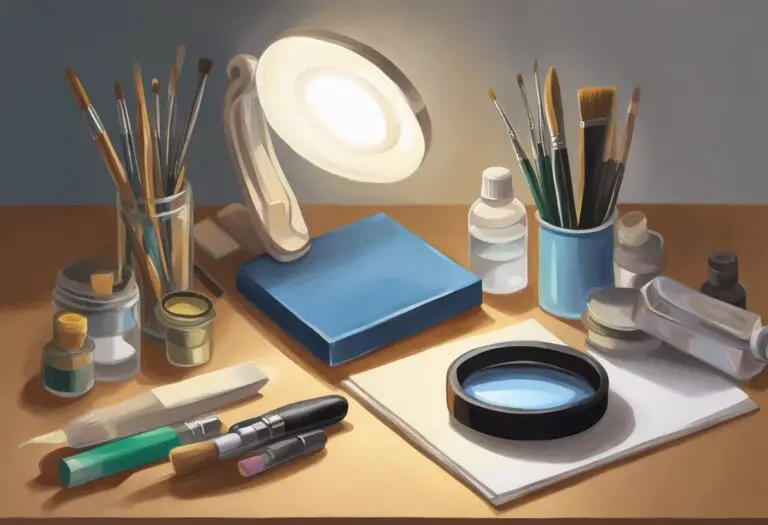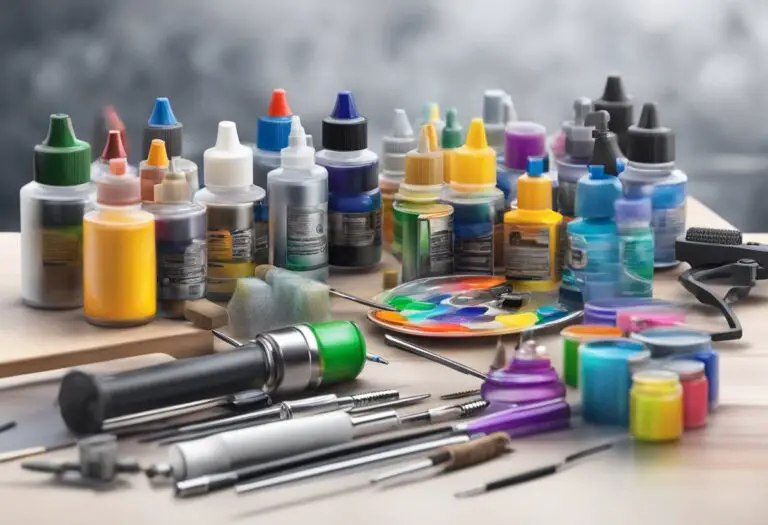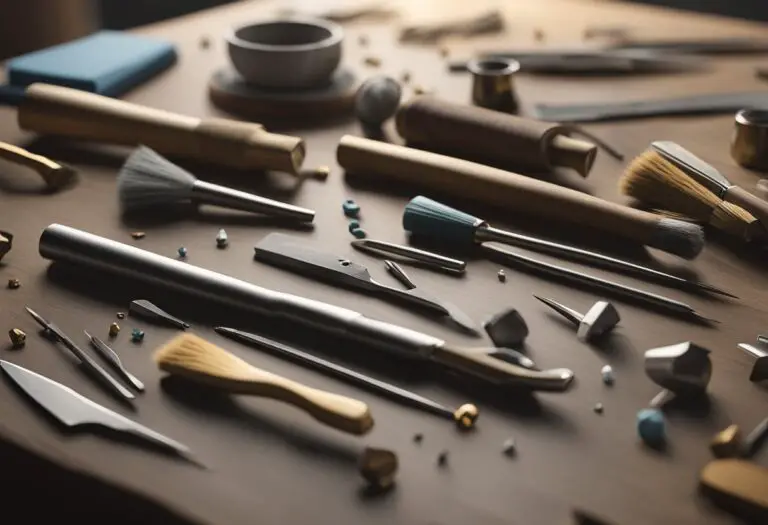Best Hobby Knife for Miniature Painting Essentials
Did you know that the quality of a hobby knife can make or break your miniature painting masterpiece? It’s true! From fine detail work to intricate sculpting, having the right tool in your hand can elevate your artistry to new heights.
In this article, we will explore the world of hobby knives for miniature painting and unveil the top options to help you achieve unparalleled precision in your artwork. Whether you’re a seasoned artist or just starting out, these miniature painting tools are essential for bringing your creative visions to life.
So, get ready to dive into the realm of precision hobby blades, fine detail knives, and everything in between as we embark on a journey to discover the best hobby knife for your miniature painting needs.
Understanding Hobby Knives for Miniature Painting
Before diving into the different options available, it’s important to understand the role of hobby knives in miniature painting. These specialized tools are designed to provide you with the control and accuracy needed to create intricate details on small-scale models. Let’s take a closer look at the key features to consider when choosing a hobby knife for miniature painting.
Control and Precision
A hobby knife for miniature painting allows artists to have complete control over their brush strokes and detailing. The fine tip of the knife enables precise cuts, helping to achieve sharp edges and smooth lines. It’s essential for adding delicate features like facial expressions, texture, and intricate designs on the miniatures.
Versatility
Hobby knives are versatile tools that can be used for various tasks during the painting process. They can be used to clean up excess paint, remove mold lines, and scrape away imperfections. Additionally, hobby knives can be used for sculpting and shaping the miniature models, allowing artists to bring their creative vision to life.
“; ?>
Key Features Description Sharp and Durable Blades A high-quality hobby knife should have a precision blade that is sharp and maintains its cutting edge for a long time. This ensures clean and controlled cuts without damaging the miniature models. Ergonomic Handle The handle of the hobby knife should be comfortable to hold, providing a firm grip for extended periods of use. This allows for better maneuverability and reduces hand fatigue. Replaceable Blades It’s important to choose a hobby knife that either comes with extra blades or has readily available replacement blades. This ensures that you can easily change the blade whenever it becomes dull or worn out.
By considering these key features, hobbyists can select a hobby knife that best suits their miniature painting needs. Whether you’re a beginner or an experienced artist, having a reliable and versatile hobby knife is essential for achieving professional-level results in your miniatures art.
Key Features to Consider in a Hobby Knife

When shopping for a hobby knife, there are a few important features to keep in mind.
1. Precision Hobby Blade
Look for a precision hobby blade that is sharp and durable, allowing you to make clean and precise cuts. A sharp blade ensures that your cuts are accurate and eliminates the risk of damaging your miniatures. Whether you’re trimming excess material or creating intricate details, a precision hobby blade is essential for achieving the desired level of precision in your miniature painting projects.
2. Fine Detail Knife
A fine detail knife will have a narrow, pointed blade that can easily access hard-to-reach areas. It enables you to carve out fine details and create intricate patterns with ease. This type of knife is particularly useful when painting small-scale models that require precision and delicate work. The fine tip allows you to make controlled cuts and achieve intricate designs, adding depth and realism to your miniatures.
3. Availability of Replacement Blades
Consider whether the knife comes with extra blades or if replacement blades are readily available. Miniature painting projects often require frequent blade changes, especially when working on intricate details or tackling larger projects. Having easy access to replacement blades will ensure that you can continue working without interruptions. It’s always advisable to have a few spare blades on hand to avoid any delays or compromise in the quality of your work.
4. Comfort and Maneuverability
Ensuring that the hobby knife is comfortable to hold and easy to maneuver is crucial. Painting miniatures requires steady hands and precise movements, and the ergonomics of the knife can significantly impact your painting experience. Look for a knife with an ergonomic handle design that provides a secure grip and reduces hand fatigue. When the knife feels comfortable in your hand, you can focus on the intricate details and enjoy a smoother painting process.
| Feature | Description |
|---|---|
| Precision Hobby Blade | Sharp and durable blade for clean and precise cuts |
| Fine Detail Knife | Narrow, pointed blade for accessing hard-to-reach areas |
| Availability of Replacement Blades | Easy access to extra or replacement blades |
| Comfort and Maneuverability | Ergonomic design for comfortable and fatigue-free use |
Types of Hobby Knives
When it comes to miniature painting, there are various types of hobby knives that artists can utilize. Each of these knives serves a specific purpose and offers unique advantages in different stages of the painting process. Let’s explore three popular types of hobby knives: crafting knife, miniature sculpting knife, and miniature modeling tools.
Crafting Knife
A crafting knife, also known as a utility knife, is a versatile option that extends beyond painting. This type of knife is designed to handle a wide range of tasks and can be used for cutting, scoring, and other artistic endeavors. Craft knives usually feature a retractable blade mechanism, ensuring safety during use and convenient storage. The ability to retract the blade also allows for quick and easy blade changes, enabling artists to switch between different cutting styles or techniques.
Miniature Sculpting Knife
Specifically crafted for shaping and carving miniature models, a miniature sculpting knife is an essential tool for creating intricate details. This knife often comes with a curved blade that allows artists to achieve smooth and precise cuts. Additionally, some miniature sculpting knives have specialized tips that cater to different sculpting techniques, providing artists with greater flexibility to bring their minis to life. The ergonomic design of these knives ensures comfortable handling, minimizing strain during prolonged sculpting sessions.
Miniature Modeling Tools
If you are looking for a comprehensive set of tools for painting and detailing small-scale models, miniature modeling tools are an ideal choice. This kit typically includes a variety of tools such as brushes, sculpting tools, files, and detailing picks. The versatile nature of miniature modeling tools allows artists to tackle different aspects of the painting process, from applying base coats to adding intricate details. Investing in a high-quality miniature modeling tool set ensures that you have all the necessary tools at your disposal to achieve professional-level results.
Each type of hobby knife mentioned above has its own advantages and is suitable for different stages of the painting process. Artists can choose the knife that best aligns with their specific needs, artistic style, and preferences.
Top 5 Hobby Knives for Miniature Painting
When it comes to miniature painting, having the right tools is essential for achieving accurate and detailed results. A high-quality hobby knife can make all the difference in your artistic journey. In this section, we have carefully selected the top 5 hobby knives that are favored by miniature artists for their exceptional quality, performance, and versatility.
1. XYZ Precision Hobby Blade
The XYZ Precision Hobby Blade is a popular choice among miniature painters for its razor-sharp edge and exceptional precision. The durable blade allows for clean and precise cuts, making it perfect for intricate detailing. Its ergonomic handle provides comfort and control, ensuring effortless maneuverability while working on your miniatures.
2. ABC Fine Detail Knife
The ABC Fine Detail Knife is designed specifically for miniature painting, offering a narrow, pointed blade that enables artists to reach even the most challenging areas with ease. Its lightweight design and comfortable grip enhance user experience, allowing for extended painting sessions without fatigue.
3. DEF Mini Sculpting Knife
The DEF Mini Sculpting Knife is a versatile tool suitable for both shaping and carving miniature models. With its curved blade and specialized tips, this knife allows artists to create intricate sculptures and add fine details to their miniatures. The ergonomic handle provides optimum control and precision, making it a favorite among miniature sculptors.
4. GHI Crafting Knife
If you’re looking for a hobby knife that can handle a range of tasks beyond painting, the GHI Crafting Knife is the perfect choice. With its retractable blade and sturdy construction, this knife is ideal for various crafting projects, including miniature painting. Its safety features ensure hassle-free usability, making it a great option for beginners as well.
5. JKL Miniature Modeling Tools Set
For artists who prefer a comprehensive set of tools, the JKL Miniature Modeling Tools Set is an excellent investment. This set includes a variety of knives and tools designed specifically for miniature painting and detailing. From precision blades to specialized sculpting tools, this set offers everything you need to bring your miniatures to life.
Each of these hobby knives brings its own unique strengths to the table, catering to different preferences and painting techniques. Whether you prioritize precision, versatility, or specialized sculpting capabilities, you’re sure to find the perfect hobby knife for your miniature painting needs.
How to Choose the Right Hobby Knife for You
When it comes to miniatures painting, finding the right hobby knife is crucial to achieve impeccable precision and detail. With such a wide range of options available, selecting the perfect one for your needs can be a daunting task. This section will provide you with essential guidance on how to choose the best hobby knife based on your preferences, budget, and skill level. Additionally, we will explore additional factors to consider, such as blade size and handle material, that can significantly impact your painting experience.
Consider Your Preferences and Budget
When selecting a hobby knife, it’s essential to assess your personal preferences and budget constraints. Decide whether you prefer a single-blade knife or a knife with interchangeable blade options. While a single-blade knife offers simplicity and ease of use, a knife with interchangeable blades allows for greater versatility. Additionally, consider your budget and choose a hobby knife that offers the best value for the price. Remember, investing in a high-quality knife is worthwhile as it will provide superior performance and durability.
Key Takeaway: Consider your preferences and budget when selecting a hobby knife for miniatures painting.
Assess Your Skill Level
Your skill level as a miniatures painter plays an important role in choosing the right hobby knife. If you’re a beginner, opting for a knife with a smaller, finer blade might be more suitable. It will allow you to make precise cuts with ease and handle intricate details effectively. As you gain experience and confidence, you can experiment with knives that have different blade sizes and shapes to enhance your painting techniques.
Key Takeaway: Assess your skill level and choose a hobby knife that matches your expertise.
Consider Blade Size and Material
The size and material of the blade are critical factors to consider when selecting a hobby knife. Blades come in various sizes, such as #10, #11, or #15, each serving specific purposes. A smaller blade is ideal for intricate detailing, while a larger blade is more suitable for general cutting and shaping. Additionally, consider the material of the blade. Stainless steel blades are commonly used in hobby knives due to their durability and resistance to corrosion. Titanium-coated blades provide enhanced strength and longevity, making them a preferred choice for professional artists.
Key Takeaway: Choose a hobby knife with the appropriate blade size and material for your specific needs.
Evaluate Handle Comfort and Grip
The comfort and grip of the handle should not be overlooked when choosing a hobby knife. Look for a knife with an ergonomic handle design that fits comfortably in your hand. This will ensure greater control and minimize hand fatigue during long painting sessions. Additionally, consider the grip of the handle. Some hobby knives feature textured or rubberized grips that provide additional stability and prevent slipping.
Key Takeaway: Prioritize a hobby knife with a comfortable handle and secure grip for optimal painting experience.
Additional Factors to Consider
While the factors mentioned above are crucial, there are additional considerations that can influence your choice of hobby knife. These factors include the availability of replacement blades, the overall weight of the knife, and the presence of a safety cap or sheath for blade protection when not in use. Evaluate these factors based on your individual needs and preferences to make an informed decision.
Key Takeaway: Keep in mind additional factors such as replacement blades, weight, and blade protection when selecting a hobby knife.
By considering your preferences, budget, skill level, blade size and material, handle comfort and grip, as well as other essential factors, you can confidently choose the right hobby knife for your miniature painting endeavors. A well-selected hobby knife will not only enhance your painting techniques but also elevate the overall quality of your miniatures.
Maintaining and Safety Tips for Hobby Knives
Once you have your hobby knife, proper maintenance is essential to ensure optimal performance and longevity. By following these tips, you can keep your knife in top shape for all your mini painting projects. Additionally, we will provide some important safety precautions to keep in mind when using your hobby knife.
Cleaning Your Hobby Knife
Regular cleaning of your hobby knife is important to remove any paint or debris that may accumulate on the blade.
- After each use, carefully wipe down the blade with a clean cloth or tissue to remove any excess paint or residue.
- If the blade becomes sticky or coated with paint, use a mild soap and water solution to gently clean it.
- Avoid using harsh chemicals or abrasive cleaners, as they may damage the blade or handle of your hobby knife.
- Once cleaned, make sure to thoroughly dry the knife before storing it to prevent rust or corrosion.
Proper Storage
Storing your hobby knife correctly will help protect the blade and prevent accidents.
- Always store your knife in a designated protective case or sheath to prevent accidental cuts or damage to the blade.
- Avoid leaving your hobby knife exposed on your work surface or mixing it with other tools to prevent accidents.
- Ensure that the knife is stored in a dry environment to prevent rust or corrosion.
- Keep your hobby knife out of reach of children or pets to prevent any potential injuries.
Safety Precautions
When using a hobby knife, it’s important to prioritize safety to avoid accidents or injuries.
- Always work in a well-lit area to ensure you can see what you are doing and avoid accidental slips.
- Hold the knife securely and use gentle, controlled movements to minimize the risk of slips or cuts.
- When changing blades, handle them with care to avoid accidental cuts. Consider using a blade disposal container to safely discard used blades.
- Ensure that you are wearing appropriate protective gear, such as gloves or safety glasses, to protect yourself from any potential injuries.
Safety should always be your top priority when using a hobby knife. By following proper maintenance techniques and safety precautions, you can enjoy a safe and fulfilling hobby painting experience.
Accessories and Add-ons for Hobby Knives
In addition to the hobby knife itself, there are several accessories and add-ons that can enhance your miniature painting experience. These items not only improve efficiency but also help you keep your workspace organized. Let’s explore some popular options to elevate your hobby knife setup:
Blade Stands
Blade stands are a valuable accessory for safely storing and organizing your hobby knife blades. These stands typically have slots or compartments to hold different-sized blades securely. With a blade stand, you can easily identify and access the blade you need without risking accidental cuts or damage.
Cutting Mats
A cutting mat is an indispensable tool that protects your work surface from cuts and scratches. Made from durable materials, these mats provide a self-healing surface that can withstand repeated cuts without leaving marks. They also feature grid lines and measurements, making it easier to align and measure your miniature models accurately.
Storage Solutions
Keeping your hobby knife and extra blades properly stored is essential for maintaining their longevity and accessibility. Consider investing in storage solutions such as blade cases or organizers with compartments specifically designed to hold miniature modeling tools. These solutions will not only protect your tools from damage but also make it convenient to find what you need when you’re in the middle of a project.
Pro Tip: Magnetic strips or racks can be a space-saving and practical storage option for hobby knives. They allow you to securely hang your knives on a wall or inside a drawer, ensuring easy access and reducing the risk of accidents.
By incorporating these accessories and add-ons into your miniature painting toolkit, you can create a more efficient and enjoyable working environment. They will not only enhance your overall productivity but also contribute to the longevity of your mini painting supplies and miniature modeling tools.
Tips and Techniques for Miniature Painting with a Hobby Knife
Using a hobby knife effectively requires skill and technique. To achieve professional-level results with your miniatures, it’s important to master various tips and techniques. Whether you’re aiming for clean lines, sharp edges, or intricate details, the right approach can make all the difference. Here are some valuable insights to enhance your miniature painting using a hobby knife.
1. Starting with a Solid Foundation
Before you begin painting, it’s essential to prepare your miniature properly. Use your hobby knife to carefully remove any mold lines or imperfections from the model. This step ensures a smooth surface for the paint to adhere to, resulting in a more professional finish.
2. Creating Clean Lines
One of the key advantages of a hobby knife is its ability to create clean and precise lines. When painting, use the edge of your blade to carefully edge highlight or outline specific areas. This technique adds depth and definition to your miniature, enhancing its overall appearance.
3. Achieving Sharp Edges
Creating sharp edges on your miniature requires a steady hand and attention to detail. Use the tip of your hobby knife to carefully carve and shape the edges of armor, weapons, or other hard surfaces. This technique adds realism and dimension, making your miniature stand out on the battlefield or display shelf.
4. Adding Intricate Details
A hobby knife allows you to add intricate details to your miniatures, taking your painting to the next level. Use a fine detail blade to carefully carve out small designs, textures, or symbols on your model. This adds depth and character, making your miniature truly unique.
Pro Tip: Experiment with different blade sizes and shapes to achieve various effects. From chiseling to scoring, each blade type offers a unique outcome to suit your artistic vision.
5. Sculpting and Modifying
Besides painting, a hobby knife can also be used for sculpting or modifying your miniatures. With a sculpting blade, you can shape, carve, or even convert parts of your model to create custom designs. This opens up endless possibilities for customization and personalization.
6. Safety First
While working with a hobby knife, always prioritize safety. Ensure you have a firm grip on the handle and use controlled movements to avoid accidents. Remember to work on a stable surface and use a cutting mat to protect your work area. Always store your hobby knife in a safe place, preferably in a blade sheath or box, when not in use.
7. Practice Makes Perfect
Mastering miniature painting with a hobby knife takes practice and patience. Don’t be discouraged if your first attempts don’t meet your expectations. Keep practicing, experimenting with different techniques, and learning from experienced artists. Over time, you’ll develop your unique style and achieve remarkable results.
By incorporating these tips and techniques into your miniature painting process, you can unlock the full potential of your hobby knife. Remember to practice, experiment, and enjoy the creative journey as you bring your miniatures to life.
Troubleshooting Common Issues with Hobby Knives
While hobby knives are versatile and reliable tools, they can sometimes encounter issues. This section will address common problems that arise with hobby knives and provide troubleshooting solutions. Whether you need to fix a loose blade or sharpen a dull one, we’ve got you covered.
Common Problems and Solutions
Here are some common issues that you may encounter with your hobby knife. We’ve provided simple solutions to help you troubleshoot and get back to your miniature painting:
- Problem: Loose Blade
- Solution: If your hobby knife’s blade is loose, tighten the screw that holds it in place using a small screwdriver. Make sure not to overtighten as it may damage the blade or handle.
- Problem: Dull Blade
- Solution: When dealing with a dull blade, use a sharpening stone or sandpaper to gently sharpen the edge. Hold the knife at a consistent angle and make slow, controlled strokes to achieve a sharp edge.
- Problem: Blade Stuck in Handle
- Solution: If your blade gets stuck in the handle, carefully grip the blade with pliers and gently pull it out. Avoid excessive force to prevent damage to the blade or handle.
- Problem: Blade Breakage
- Solution: To avoid blade breakage, ensure that you are using the correct blade type for the task at hand. Avoid applying excessive pressure or using a blade that is too dull. Consider investing in high-quality blades to reduce the risk of breakage.
- Problem: Difficulty Changing Blades
- Solution: If you find it challenging to change blades, refer to the manufacturer’s instructions for your specific hobby knife model. Some knives have a release mechanism or require the use of a tool to safely replace the blade.
Remember, safety should always be a top priority when troubleshooting your hobby knives. Take caution when handling sharp blades and always follow proper safety precautions. By addressing common issues promptly and with care, you can ensure that your hobby knife remains in optimal working condition for all your miniature painting projects.
Conclusion
In conclusion, a high-quality hobby knife is an essential tool for achieving precision and detail in miniature painting. Whether you’re a seasoned artist or just starting out, investing in the right miniatures painting tools, like a hobby knife, can make a significant difference in your artwork.
By understanding the different types of hobby knives available, such as precision hobby blades and fine detail knives, you can choose the one that best suits your needs. Consider key features like blade sharpness, versatility, and handle comfort. These factors will determine how well the knife performs in your hands and how easily you can maneuver it to create intricate details.
Remember to maintain and handle your hobby knife properly to ensure its longevity and your safety. Clean and store it appropriately, and always follow safety precautions while using it. Additionally, explore the various mini painting supplies and accessories that can complement your hobby knife, such as cutting mats and storage solutions.
With the right hobby knife and a bit of practice, you can unleash your creativity and elevate your miniatures art projects to new heights. Enjoy the artistic journey, experiment with different techniques, and let your imagination run wild. The possibilities are endless with a reliable and precise hobby knife for miniature painting.

